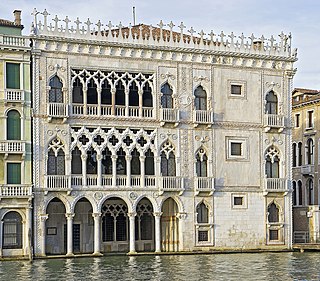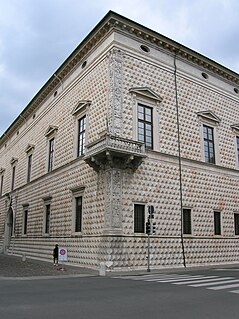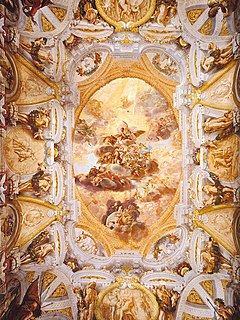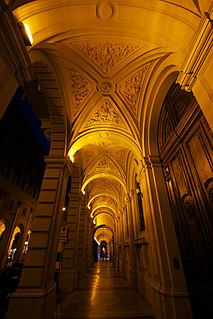
The Palazzo Grassi is Gothic-style, 13th-century palace located on Via Marsala #14 in Bologna, region of Emilia Romagna, Italy. The palace in 2015 houses the Circolo Ufficiali dell'Esercito, a private Officer's club.

The Palazzo Grassi is Gothic-style, 13th-century palace located on Via Marsala #14 in Bologna, region of Emilia Romagna, Italy. The palace in 2015 houses the Circolo Ufficiali dell'Esercito, a private Officer's club.
The palace once belonged to the Canonici family, but was acquired by the Grassi family in 1466, and remained with their descendants until 1848. In 1478, the family was honored with the title of Conti Palatini del Sacro Romano Impero by Frederick III, Holy Roman Emperor. In 1865, the palace was acquired by the military. It underwent a number of renovations, with the latest in the 20th century, and in 1935 it became the home of the Circolo club. [1]
The palace still retains a wooden portico columns for part of the facade. The portals have a peaked entrance. Inside the courtyard are intaglio works by Properzia de Rossi and a 16th-century terracotta depicting a Madonna with Child. The palace chapel, has stucco decoration by Giuseppe Maria Mazza and frescoed decoration (1704) is by Ercole Graziani. [2]

The Ca' d'Oro or Palazzo Santa Sofia is a palace on the Grand Canal in Venice, northern Italy. One of the older palaces in the city, its name means "golden house" due to the gilt and polychrome external decorations which once adorned its walls. Since 1927, it has been used as a museum, as the Galleria Giorgio Franchetti.

The Palazzo Pitti, in English sometimes called the Pitti Palace, is a vast, mainly Renaissance, palace in Florence, Italy. It is situated on the south side of the River Arno, a short distance from the Ponte Vecchio. The core of the present palazzo dates from 1458 and was originally the town residence of Luca Pitti, an ambitious Florentine banker.

Palazzo Grassi is a building in the Venetian Classical style located on the Grand Canal of Venice (Italy), between the Palazzo Moro Lin and the campo San Samuele.

Palazzo dei Diamanti is a Renaissance palace located on Corso Ercole I d'Este 21 in Ferrara, region of Emilia Romagna, Italy. The main floor of the Palace houses the Pinacoteca Nazionale di Ferrara.

Palazzo Bianco is one of the main buildings of the center of Genoa, Italy. It is situated at 11, via Garibaldi.

The Palazzo Corsini is a prominent late-baroque palace in Rome, erected for the Corsini family between 1730–1740 as an elaboration of the prior building on the site, a 15th-century villa of the Riario family, based on designs of Ferdinando Fuga. It is located in the Trastevere section of the city, and stands beside the Villa Farnesina. During 1659–1689, the former Riario palace had hosted the eccentric Christina, Queen of Sweden, who abdicated, converted, and moved to Rome. Under her patronage, this was the site for the first meetings of the Roman Accademia dell'Arcadia.

Via de' Tornabuoni, or Via Tornabuoni, is a street at the center of Florence, Italy, that goes from Antinori square to ponte Santa Trinita, across Santa Trinita square, characterized by the presence of fashion boutiques.

Palazzo Aragona Gonzaga is a 16th-century palace in Rome, Italy; it was once the residence of Cardinal Scipione Gonzaga. Today, its late Renaissance street facade bears plaques commemorating two of its residents, Saint Aloysius Gonzaga and the poet Torquato Tasso.

Palazzo dell'Antella is a palace with a frescoed façade located on Piazza Santa Croce, Florence, region of Tuscany, Italy.

The Palazzo Ghini is a palace of the aristocratic Ghini family in Cesena, Italy. Located in Corso Sozzi, it is the best known of the five palaces of the same family. Its location in the old center of Cesena has been the site of many archeological finds indicating that several Roman buildings stood there in the 3rd–2nd centuries BC.

The Palazzo Orsini di Gravina is a Renaissance-style palace on number 3 Via Monteoliveto, in the San Lorenzo quarter of Rione San Giuseppe-Carità, of central Naples, Italy. Since 1940, it has housed the Faculty of Architecture of the University of Naples. It is located across the street and a few doors north of the sleek and modern Palazzo delle Poste. Across the street at the north end of the palace, is the Piazza Monteoliveto with its Fountain and the church of Sant'Anna dei Lombardi.

The Palazzo Pepoli Campogrande, also known as Palazzo Pepoli Nuovo, is a Baroque style palace on Via Castiglione 7 in central Bologna, region of Emilia-Romagna, Italy. In 2015, it served as a public art gallery for late-Baroque art. Across the Via, rises the medieval Palazzo Pepoli Vecchio, also once pertaining to the same family, which now serves as a museum of the history of Bologna.

The Palazzo Legnani Pizzardi, also known as Palazzo Pizzardi e Volta or just Palazzo Pizzardi, is a Renaissance style palace located on Via d'Azeglio #38, corner with Via Farini, in central Bologna, Italy. In 2015, the palace housed the Tribunal of Bologna.
The Palazzo Leoni is a Renaissance style palace located on Via Marsala #31, in front of the outlet of Via Mentana, in central Bologna, region of Emilia-Romagna, Italy. The apse of the church of San Martino, is across the street.

Palazzo dei Convertendi is a reconstructed Renaissance palace in Rome. It originally faced the Piazza Scossacavalli, but was demolished and rebuilt along the north side of Via della Conciliazione, the wide avenue constructed between 1936 and 1950, which links St Peter's Basilica and the Vatican City to the centre of Rome. The palace is famous as the last home of the painter Raphael, who died there in 1520.

The Palazzo Isolani is a palace located on located on Via Santo Stefano #16 facing Piazza Santo Stefano in the center of Bologna, region of Emilia-Romagna, Italy, with both Gothic and Renaissance architecture features.
The Palazzo Orsini is a neoclassic-style palace located on via Borgonuovo #11 in Milan, region of Lombardy, Italy.
The Palazzo del Circolo dell'Unione, also once known across the centuries as the Palazzo Corsi, Montauto, or della Commenda da Castiglione, is a late-Renaissance-style palace located on Via Tornabuoni #7 in central Florence, region of Tuscany, Italy. In 2015, it still houses the Circolo society, and houses among other enterprises, a boutique hotel.
The Palazzo Zagnoni, also known as Palazzo Spada, is a Neoclassic-style palace located on Via Castiglione 25-27, in Bologna, region of Emilia-Romagna, Italy.

The Palazzo del Giardino or Palazzo Ducale del Giardino is a historic palace in the Parco Ducale in Parma. It is not to be confused with the official Parma residence of Marie Louise, Duchess of Parma between Palazzo della Pilotta and Palazzo della Provincia in what is now known as piazzale della Pace - she also lived at the Ducal Palace of Colorno and in the Casino dei Boschi in Sala Baganza. The main Ducal Palace in Parma, the Palazzo della Pilotta and the teatro Reinach were all destroyed in bombing on 13 May 1944.
| Wikimedia Commons has media related to Palazzo Grassi (Bologna) . |
Coordinates: 44°29′50.6″N11°20′43.00″E / 44.497389°N 11.3452778°E